https://www.truthdig.com/photo-essays/drop-acidand-psychedelic-cluster-bombs/PHOTO ESSAY
Drop Acid…and Psychedelic Cluster Bombs?
RUSSELL HAUSFELD / TRUTHDIGDECEMBER 28, 2022A photo essay of the U.S. military’s weaponization of hallucinogens, culminating in the stockpiling of super-psychedelic “BZ” cluster bombs. 11 PHOTOSThis is part of the “The Ecstasy of Agony“ Dig series.
Former CIA counterterrorism agent John Kiriakou recently highlighted that, in 2020, the CIA announced plans to return to the lab under an initiative called CIA Labs. Considering the CIA’s track record with science and technology development, Kiriakou thinks that the CIA should not be allowed to research solutions to what the agency calls “tomorrow’s intelligence challenges.”
“The C.I.A. has proven time and time again that it can’t be trusted,” Kiriakou wrote. “It has proven that it will simply push the envelope into the realm of illegality if it thinks it can get away with it.”
The former agent has history on his side. Decades prior to the “psychedelic renaissance” embrace of psychedelic drugs as mental health treatments, the United States government — through the Central Intelligence Agency and the Army Chemical Corps — attempted to utilize the drugs as chemical weapons and interrogation tools.
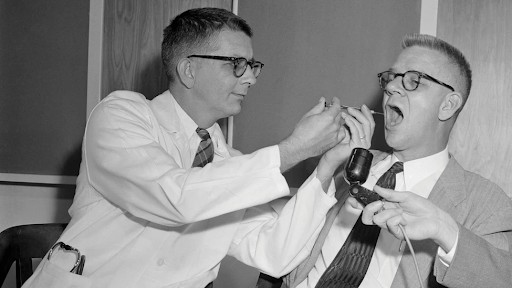
CIA researcher Carl Pfeiffer (right) is given a dose of LSD; he would later administer it to prisoners. (Source: Bettmann/Getty Images)
Many CIA researchers experimented on themselves — and other unwitting individuals — with psychedelic drugs during the MKULTRA experiments between the 1950s and 1970s. The CIA was exploring the potential for turning the chemical agents into aids to interrogation capable of forcing confessions, brainwashing and psychologically torturing prisoners. Many of the records of MKULTRA were destroyed on the order of then-CIA-Director Richard Helms in 1973. But thousands of documents relating to MKULTRA were uncovered in 1977 thanks to a Freedom of Information Request, and further information related to MKULTRA was declassified in 2001.
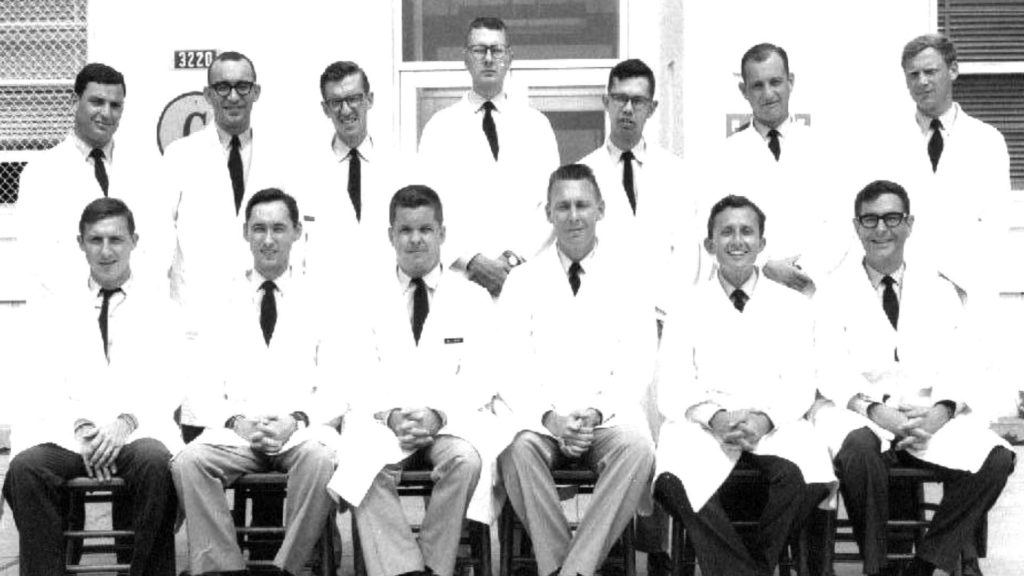
Researchers of Edgewood Arsenal. Back row, from left: Drs. Sussman, Safer, Hayes, Crowell, 1st Lt. Hart, Drs. Gipstein, Gottlieb. Front row, from left: Drs. Simmonds, Pless, Sidell, Ketchum, Goldstein, Needle (Source: “Chemical Warfare: Secrets Almost Forgotten”)
Alongside the CIA, the U.S. Army Chemical Corps was also experimenting with psychedelics as one class of a larger chemical agents project. Some Army researchers claimed ignorance of the CIA experiments happening around the same time.
The Army’s Edgewood Arsenal research labs are infamous for the lasting damage their experiments wrought for U.S. Army volunteers. One purpose of these experiments was to evaluate the impact of low-dose chemical warfare agents on military personnel. A number of personnel who took part in these experiments have since filed lawsuits against U.S. agencies for ongoing trauma; lack of proper informed consent at the time of volunteering; and improper compensation and health care benefits for research volunteers.


Top: Cat not on LSD. Bottom: Cat on LSD terrified of mouse. (Source: Screengrabs of United States Chemical Corps video declassified in 2016)
The U.S. government tested a number of psychoactive drugs on both animals and humans. In his report “Paradise Lost: The Psycho Agents,” Reid Kirby describes one test in which a cat was “exposed to an aerosol of LSD [and] became frightened of a mouse.” Documents from this time reveal that the Army administered LSD on subjects using aerosolization, injection and swallowing. The experiments also explored derivatives of THC, mescaline and PCP.
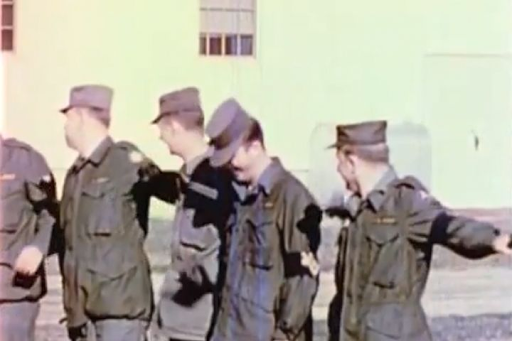
Soldiers giggling while testing LSD at Edgewood Arsenal (Source: “Effects of Lysergic Acid Diethylamide (LSD) on Troops Marching,” National Archives and Records Administration)
In the photo above, a group of soldiers in 1958 attempt to remain composed during drills while on LSD, but are plagued with fits of giggling. Over time, LSD was abandoned in favor of a more potent hallucinogenic deliriant called “BZ,” which was weaponized but allegedly never used in the field. “Evidently, BZ was less expensive to produce than LSD…There was also the problem in that the Chemical Corps was employing LSD without a license from the rightful patent holders,” according to Reid Kirby’s “Paradise Lost: The Psycho Agents.” A U.S. patent for LSD was issued to pharmaceutical company Sandoz in 1948, naming chemists Albert Hofmann and Arthur Stoll as co-inventors.

Progression of one subject’s “Draw a Man” test while on the hallucinogenic deliriant BZ (Source: Photo collage by Russell Hausfeld, images from “Chemical Warfare: Secrets Almost Forgotten”)
The effects of BZ left those exposed to it with hallucinations and delirium that could last multiple days. This delirious state can be observed in the “Draw a Man” tests completed by participants while under the influence of BZ, illustrating the deterioration and eventual restoration of participant’s mental states over the course of the experience. The government’s experimentation with BZ has been critiqued by journalists and dramatized in films like “Jacob’s Ladder.”
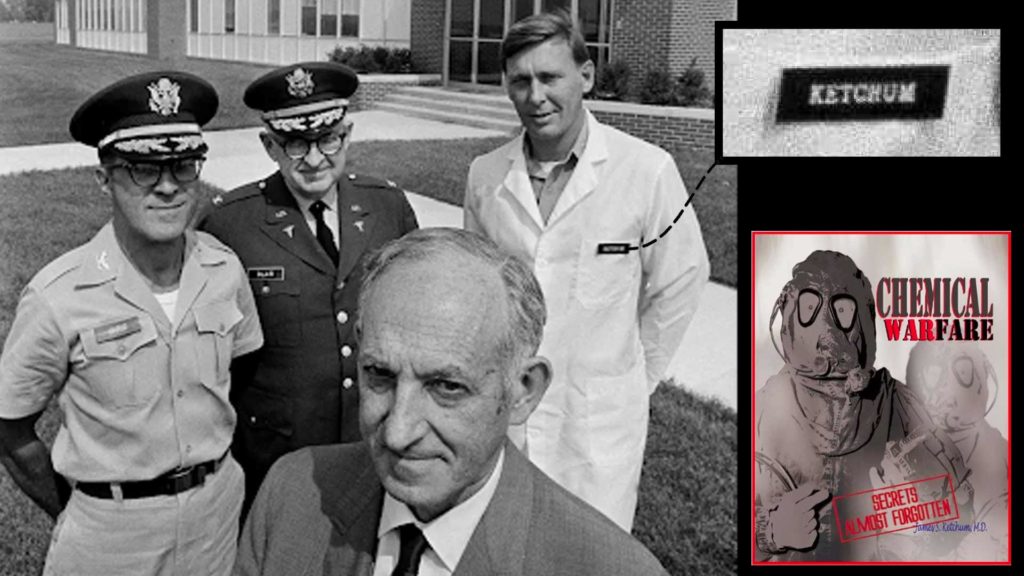
Left: Edgewood deputy director of medical sciences, Lt. Col. James Ketchum (back-right), poses with other Edgewood staff in front of research facilities (Source: AP). Right: Cover of Ketchum’s 2006 book, “Chemical Warfare: Secrets Almost Forgotten”
One researcher from Edgewood, Dr. James Ketchum, wrote about his experience in the 2006 book, “Chemical Warfare: Secrets Almost Forgotten,” and took issue with media depictions of BZ. Ketchum stated in the book that “one of the most egregious errors made by writers referring to BZ in lay publications…is to characterize it as some kind of ‘super potent hallucinogen’ developed by the Army for purposes of riot control, or as a horrible chemical weapon. Such unfair descriptions put an unfair Dr. Strangeloveian stamp on Army chemical research.”
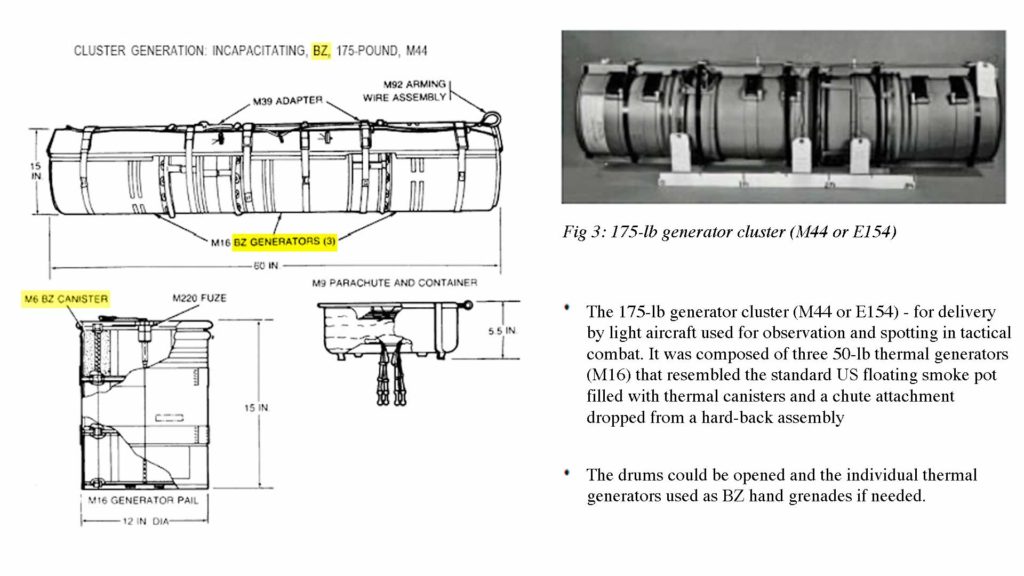
Left: Schematics for M44 BZ Cluster (Source: U.S. Army Technical Manual (TM 43-0001-26-2), April 29, 1982). Right: Screengrab from Reid Kirby’s “Paradise Lost: The Psycho Agents” report.
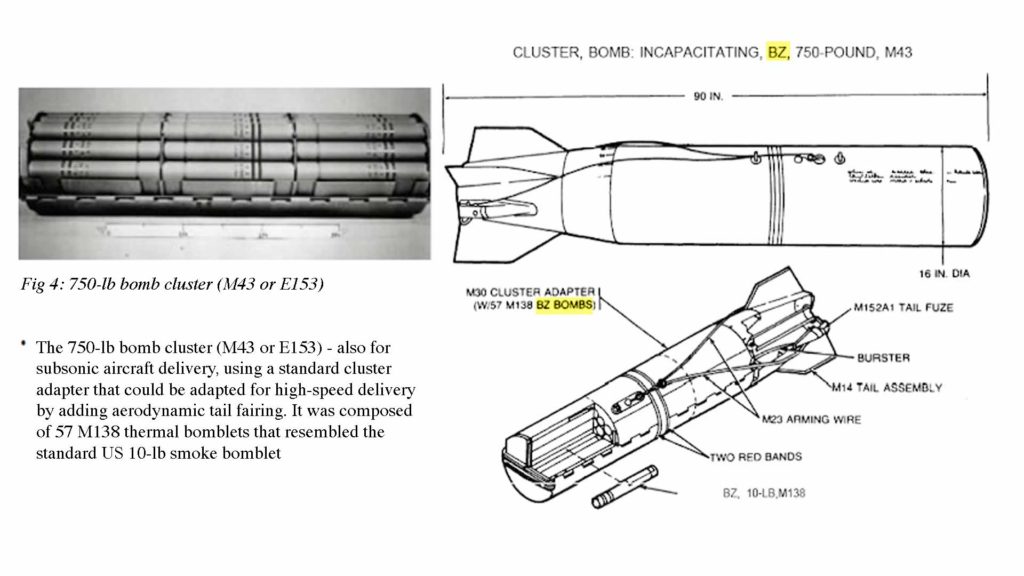
Left: Screengrab from Reid Kirby’s “Paradise Lost: The Psycho Agents” report. Right: Schematics for M43 BZ Cluster Bomb (Source: U.S. Army Technical Manual (TM 43-0001-26-2), April 29, 1982)
Contrary to Ketchum’s feelings about media depictions of BZ research, BZ is without a doubt a “super potent hallucinogen,” and the Army designed literal BZ cluster bombs to drop on enemies. Ketchum’s own writing on the potency of hallucinations caused by LSD and BZ make a case for it being “super potent.” He writes in “Chemical Warfare” that while LSD produced hallucinations that subjects generally understood as “unreal,” BZ caused a “true loss of contact with reality.” All Army stocks of BZ were destroyed in 1989 as part of a general downsizing of the U.S. chemical warfare program. Since then, other governments have been accused of weaponizing BZ and chemicals like it.
Further Reading:
– “Acid Dreams” by Martin A. Lee and Bruce Shlain
– “Poisoner in Chief” by Stephen Kinzer
– “Chemical Warfare: Secrets Almost Forgotten” by James Ketchum
– “Operation Delirium” by Raffi Khatchadourian



Geen opmerkingen:
Een reactie posten